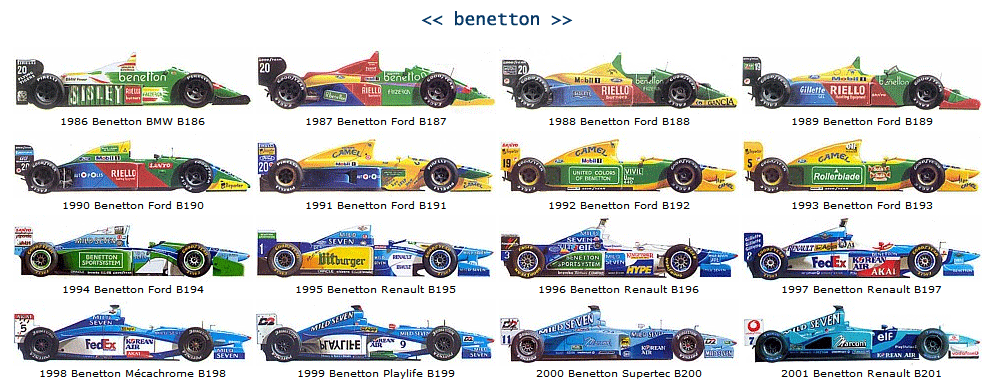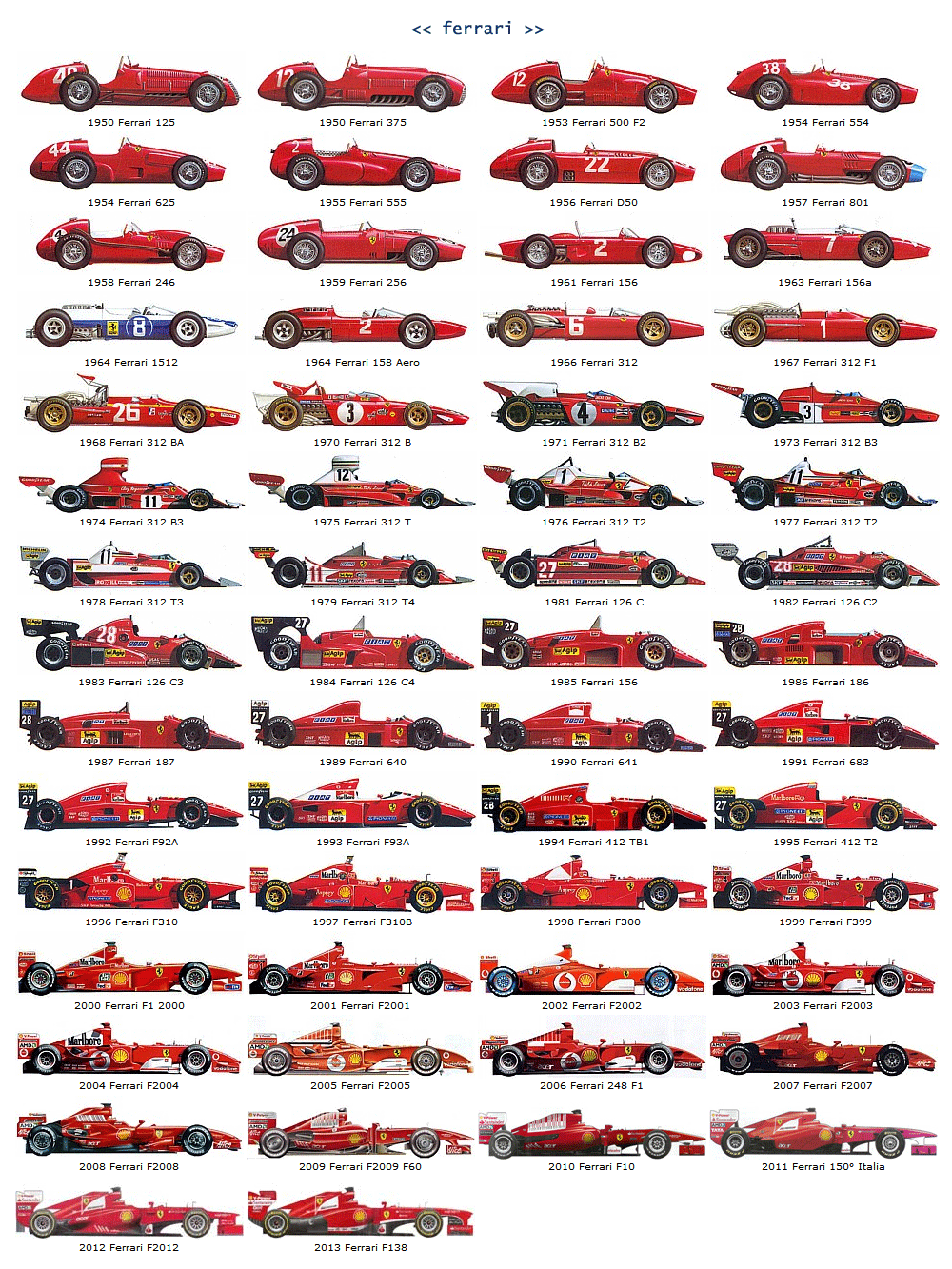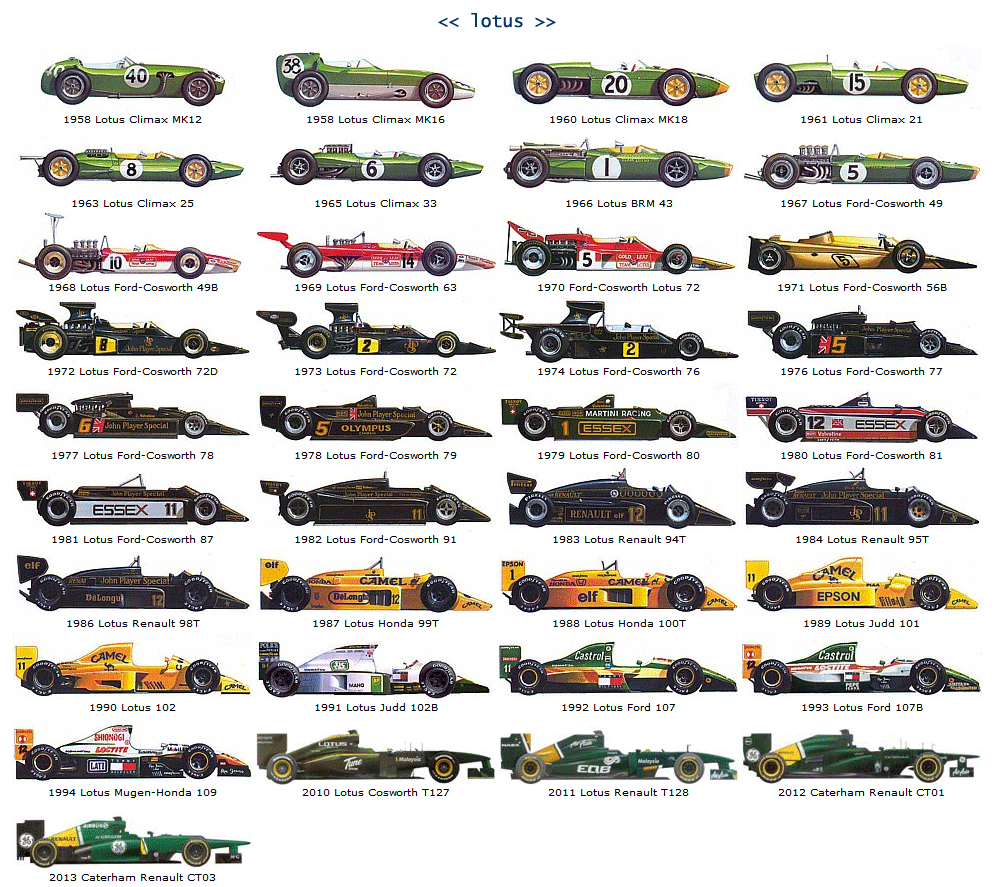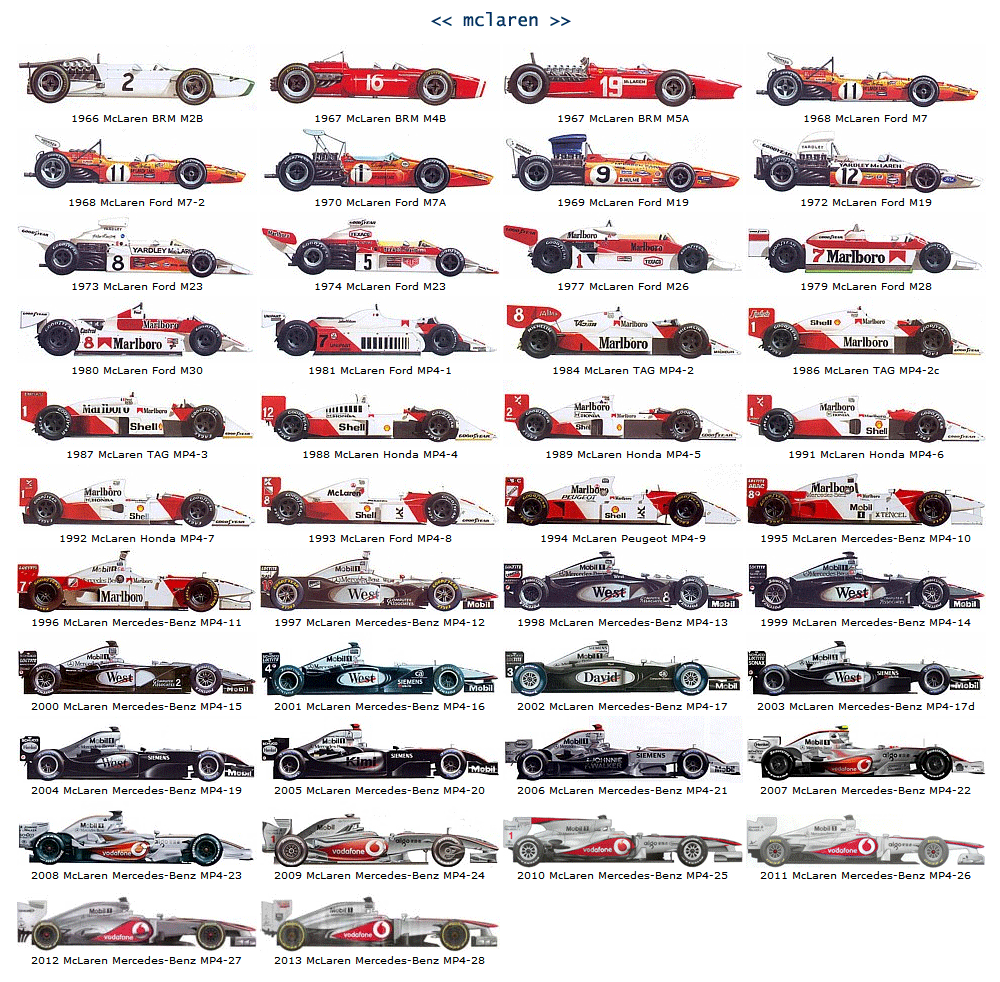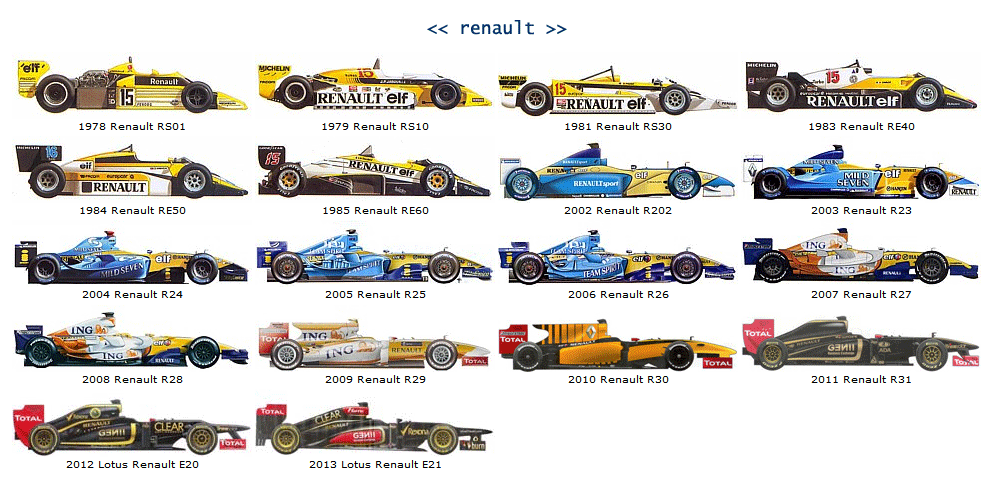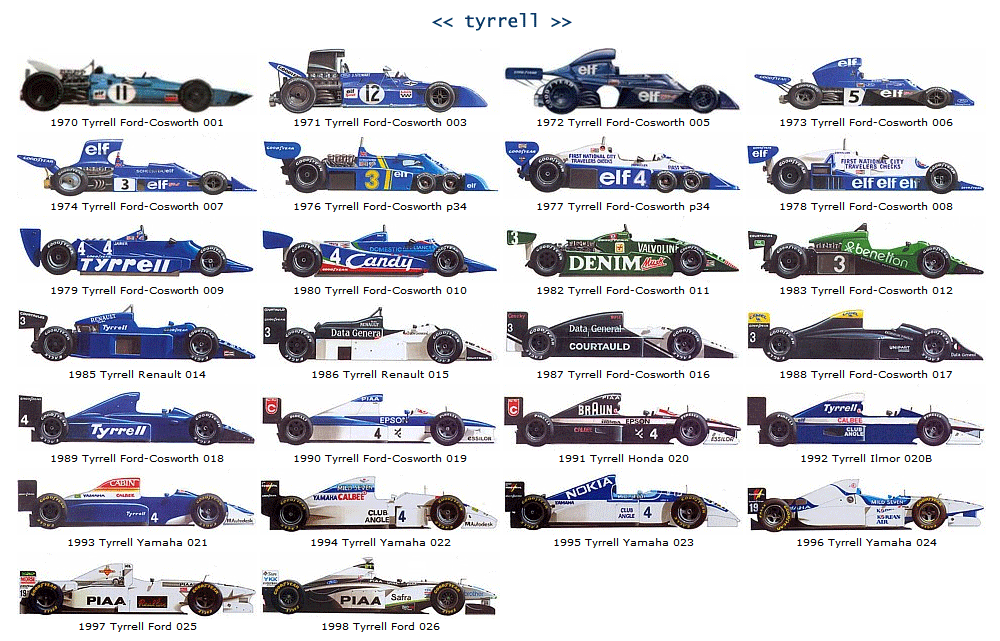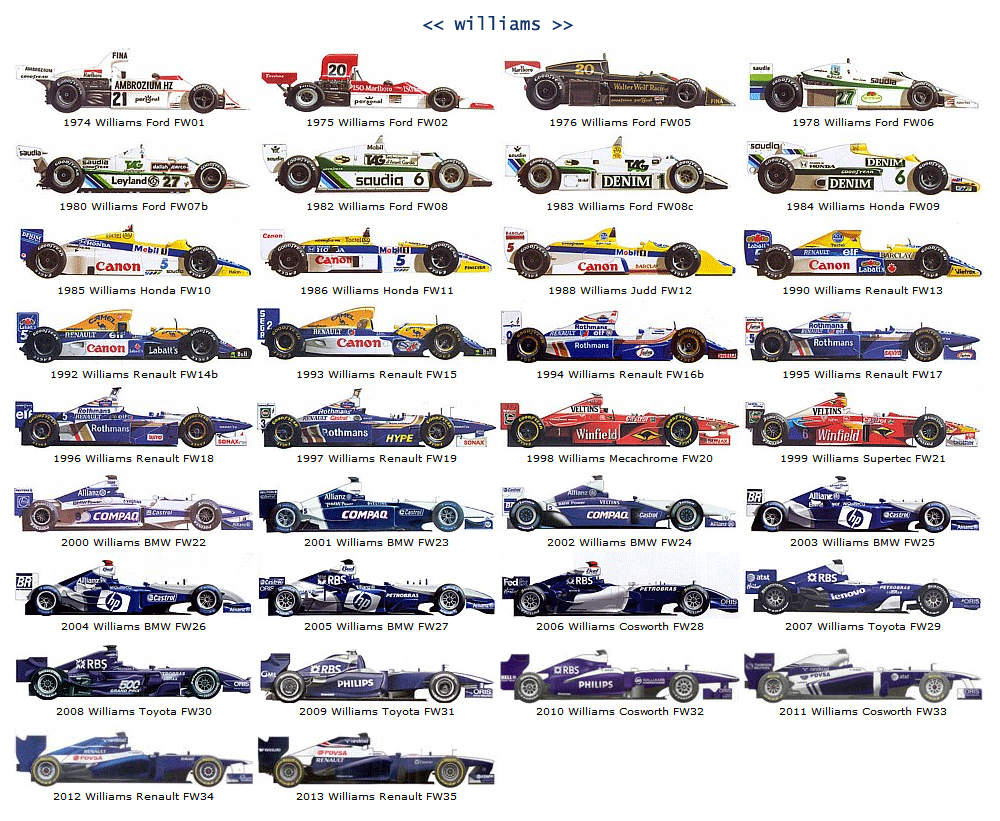Top Ten Greatest Formula 1 Designers (by Tim Ferrone)

The role of the designer in Formula 1 has changed over the years, but it has always been vitally important.
In the early days of the world championship designers thought up entire cars from scratch – sometimes including the engine.
Today the top designers are one element in vast teams with considerable resources. But while the individual components of a car are subject to rigorous development by specialists of great expertise, there remains the need for a single designer who has the vision to decide on a development direction.
They are the king-makers. While the drivers command the most attention, it’s the designers give them their tools to get the job done in the first place. Here are ten of the greatest of them all.
10. Gerard Ducarouge
Ducarouge’s top flight career reached dizzying heights very quickly with the title winning Matra MS80 of 1969. Driven by Jackie Stewart, the car was one of the first to feature downforce-inducing wings with the purpose of increasing cornering speeds by using the passage of airflow to force the car down onto the circuit
He oversaw a hat trick of Le Mans wins prior to Matra’s withdrawal from motorsport. The company was bought out by Guy Ligier at the end of 1974, taking its designer with it. The new team hit the ground running, delivering its first win at Sweden in 1977.
The following year’s car, the JS9, was effectively designed as one giant wing. Its 1979 successor, the JS11, was a serious title contnder. Taking several early-season victories, it was only when Ferrari introduced the 312T4 chassis that Ligier fell behind in the development race and out of title contention.
After a brief spell at Alfa Romeo followed Ducarouge joined Lotus, and quickly turned around the fortunes of a team that was is disarray following the death of foudner Colin Chapman. Ducarouge’s much improved design began to restore the team to something approaching its former glory in the second half of 1983. His new 94T was, incredibly, turned around in just five weeks, and proved competitive from the outset.
The following season’s car was good enough for Elio de Angelis to end the year third behind the all-conquering McLaren drivers.
In 1985 the 97T was a regular contender for victory, particularly in the hands of Ayrton Senna. It featured another Ducarouge innovation, barge boards, designed to direct airflow more effectively around the car’s rear. It took eight pole positions but ultimately fell out of title contention through poor reliability.
Ayrton Senna, Lotus-Honda 99T, Autodromo Hermanos Rodriguez, 1987Much the same was true in the following two seasons. The 99T raced in 1987 was featured an early computer-controlled active suspension system.
It was relatively successful at smoothing out pitch and roll and maintaining the car’s consistent ride height, but suffered from extra weight which hampered performance. But Senna won around the slow Monaco and Detroit courses, giving the technology its first victories.
A disappointing campaign in 1988 saw Ducarouge return to his native France with the newly-formed Larrousse team, and eventually back to Ligier, but he was unable to make a significant difference to the respective team’s fortunes.
He eventually retired from the world of Formula 1 midway through the 1994 season, bringing to an end a successful career at the very pinnacle of Grand Prix racing.
9. Owen Maddock
Rear-engined racing cars had been seen long before Maddock’s Coopers of the late fifties – notably the pre-war Auto Unions.
But Maddock’s refinement of the concept marked a watershed moment in the sport. Very soon the rear-engined refuseniks – chief among them Enzo Ferrari – were forced to bow to the inevitable relocation of the motor behind the drivers. And it’s been that way ever since.
Maddock joined the newly-formed Cooper Car Company in 1948, starting out as a fitter. It became clear very quickly that his was a mind with much more to offer, and his role increasingly began to use his training as a draughtsman. It wasn’t long before his skills in this area were formally recognised with a permanent role as Cooper’s chief designer, encompassing the design of a vast array of sports cars and single seaters.
His first significant breakthrough came in 1954 when, with the encouragement of Charlie Cooper, he introduced bent chassis tubes throughout the car’s frame. This went against the thinking of the time – using curved tubes allowed the chassis to better match the shape of the car’s body, removing the need for additional supports and resulting in a much smaller and lighter end product.
But Maddock’s rear-engined cars were the game-changers. Stirling Moss took the first F1 victory for a rear-engined car at Argentina in 1958. His Cooper T43, which featured another Maddock hallmark, leaf-spring suspension.
Jack Brabham used the T51 and T53 to win the drivers’ championship in 1959 and 1960 while Cooper cleaned up in the constructors’ championship. The second season was a year of dominance for Cooper, the T53 enhanced by Maddock’s super-reliable C5S racing gearbox which addressed the previous car’s one major shortcoming.
However a change of engine regulations the following season, followed by the departure of Brabham, with whom Maddock had formed a brilliant developmental partnership, pitched the Cooper team into a slow decline from which it would never recover. Feeling trapped within the confines of the drawing office, and excited by the development of hovercraft technology, Maddock left top flight motorsport, albeit he continued to freelance for Bruce McLaren’s fledgling new team in the sixties.
Included here not just for his far-sighted capacity for design, but also for being the driving force behind the rear-engined revolution, there can be no doubting Maddock’s importance to the development of Formula 1, or his contribution to the success of a once great British motor racing institution.
8. Harvey Postlethwaite
Harvey Postlethwaite’s emergence as a top F1 designer began with the Hesketh team. Sporting unusual but efficient rubber spring suspension, his 308 beat the might of Ferrari and Niki Lauda to victory in the 1975 Dutch Grand Prix
A move to the Wolf team in 1977 saw his brand-new WR01 secure victory first time out, and eventually allowed Jody Scheckter to finish as runner up in the drivers’ championship (the single-car team was a distant fourth in the constructors’).
Following hot on the heels of Colin Chapman’s Lotus team, Postlethwaite was among the first to harness the potential of sliding skirts/ground effect with the 1978 Wolf. His next car, the WR7, featured a sleek monocoque construction that eliminated the weak joints of previous fabricated designs.
His progress brought him to the attention of Ferrari, whose aerodynamic shortcomings were increasingly holding the team back.
Postlethwaite’s first car for them, the 126C2, transformed the team’s fortunes. From finishing a lowly fifth in the constructors’ championship in 1981, the team won the title the title the following year.
Tragically, Gilles Villeneuve was killed driving the car at Zolder and team mate Didier Pironi suffered career-ending injuries at the Hockenheimring.
Although the team were constructors’ champions again in 1983, the new driver line-up of Rene Arnoux and Patrick Tambay fell short in the drivers’ title race.
More victories followed in the mid-eighties but Ferrari fell short of the standard set by McLaren and Williams. Postlethwaite returned to designing cars for smaller teams, joining Tyrrell.
Many of his design principles remain fundamental to modern F1 racing. His high-nosed Tyrell 019 literally changed the face of F1 cars, demonstrating the value of maximising airflow under the car.
Some of his most creative developments came when budgets were at their tightest, including hydrolink hydraulic passive suspension, the pneumatic semi-automatic gearbox and the infamous X wings – the latter originally crafted from surplus carbon fibre as a quick means of adding downforce in an area not proscribed by the rules.
Postelthwaite earns his place on this list bot just for his championship-winning years with Ferrari, but also his capacity to maximise often minimal resources.
Vittorio Jano
Vittorio Jano was born before the turn of the 20th century and, like many drivers born around the same time, missed several years of competition due to the war years.
After the First World War he began working for Fiat. Alfa Romeo, seeking to use motor sport as a promotional platform for their production cars, were quick to sign him up. Tasked with creating a winning race car from scratch, Jano did just that. His P2 took victory in its first race, as well as winning at the Grand Prix of Europe in 1923.
He went on to design the first true single seater racing car, the P3 Monoposto, which also took victory first time out at the Italian Grand Prix of 1932. It was a pioneering design, light in weight, and allowed the driver to sit much lower in the cockpit due to the use of twin driveshafts to drive the rear wheels.
This was followed by a move to Lancia shortly after the death of Vicenzo Lancia in 1937. After the Second World War, Jano created the Lancia D50 which first raced in 1954
The D50 was another pioneering design. The light chassis featured an engine mounted at twelve degrees in order to reduce the frontal area of the car. This allowed the driver to be seated even lower.
It was the first car to use the engine as a partially-stressed member. Weight distribution was optimised by situating the fuel tanks were situated either side of the cockpit, in between the front and rear wheels. The car qualified a full second quicker than Juan Manuel Fangio’s hitherto all-conquering Mercedes on its debut in the 1954 season finale, but failed to finish the race.
The death of Alberto Ascari in the middle of 1955, and Lancia’s financial trouble, threatened to rob the car of its promised Grand Prix successes. But Ferrari purchased the cars for 1956 and it was raced to the title by Fangio, the team winning five of that year’s eight races.
Working alongside Carlo Chiti, Jano’s final championship came via the 1958 Ferrari 246, which proved to be the last front-engined car to win a Grand Prix, but more significantly was the first to feature a V6 engine. In fact, with much encouragement from Dino Ferrari, Jano was the key player in the development of Ferrari’s V6 and V8 engines.
Tragically, Jano took his own life in 1965 after falling seriously ill, and following the death of his son earlier that year. It was a sad end to the life of a man whose racing creations often enjoyed instant success.
6. Gordon Murray
As is the case for several of the names on this list, Gordon Murray’s lifelong interest in vehicles and motorsport can be traced back to a little racing in the blood.
His father raced motorbikes and latterly had involvement in the preparation of racing cars in their native Durban, so it was a logical step when Gordon went on to study mechanical engineering at Natal Technical College. Initially a driver in the South African National Class, he actually built and raced his own IGM Ford car during 1967 and 1968, before moving to Britain in the hope that he could find employment with Lotus.
A chance meeting with Ron Tauranac led instead to an offer to join Brabham as a draughtsman. Within two years, the arrival of Bernie Ecclestone as team boss saw Murray promoted to the role of chief designer.
It was clear from the outset that Murray sought to gain advantage through innovation. The BT42 he designed for the 1973 season featured an extraordinary triangular cross section, and proved relatively successful. It also boosted Murray’s confidence in his own methodology.
This reluctance to follow the crowd was an approach that was to point the way for the rest of his career. Seeking a competitive edge, the thought process behind Murray’s free-thinking was simple; rather than approaching car design as having done it hundreds of times previously, it would be beneficial to approach from afresh, as if doing so for the first time. With that mindset, Murray was able to conceive new ideas, rather than follow perceived conventional wisdom.
The results of this approach were numerous, and often controversial. The BT46B of 1978 won the Swedish Grand Prix largely thanks to the enormous fan mounted at the car’s rear. Though it did have some cooling purposes its primary function was to suck the car to the ground, creating an even more powerful version of the ground effect pioneered by rivals Lotus. Devastatingly effective, as a ‘moveable aerodynamic part’ it was quickly deemed illegal and never raced again in the same form.
Concerned about increased cornering speeds, the 1981 regulations sought to outlaw ground effect by mandating a minimum 6cm gap between floor and car, and forbidding any driver operated aids to reduce the gap when the car was in motion.
It was Murray who spotted that the authorities could only measure the car when stationary, and that they would have to allow some degree of flexibility on this rule when the car was in motion due to the natural pitch and role experienced during cornering and breaking. He therefore devised an ingenious use of hydro-pneumatic suspension struts for each wheel. As the BT49C accelerated, hydraulic fluid was gradually pushed out of the struts, lowering the car ride height, recreating the ground effect the rule-makers had strived to ban. As the car decelerated at the end of a session or race, the fluid slowly returned into the struts, thus returning the car’s height to the regulated 6mm height.
It was a brilliant example of exploiting the wording of the regulations, rather than their actual intention, and helped deliver Nelson Piquet’s first world championship.
Murray also had a hand in improving electronically delivered information to drivers, carbon fibre brake discs, and even an air-jacking system that was built into the car, designed to accelerate tyre changes. In 1983 his devastatingly effective BT52 was produced in a hurry following the final banning of ground-effect, and took advantage of the rise of in-race refuelling to produce a compact and powerful car which made Piquet a champion again.
At times Murray’s radical thinking led him down the wrong path. The BT55 of 1986 was conceived with the aim of reducing frontal cross-section and getting as much clean airflow to the rear wing as possible. However its BMW engine could not be made to work in this ‘lowline’ configuration, and the car never reached its potential. Worse, Elio de Angelis lost his life in a crash while testing it at Paul Ricard in 1986.
As Ecclestone’s interest in his Brabham team waned Murray moved to McLaren. Here he revived the lowline concept to devastating effect with the MP4-4. Perhaps the most dominant F1 car ever built, it won 15 wins from 16 races in 1988.
Drivers’ and constructors’ titles again followed in ’89, but Murray had grown bored and frustrated with the increasingly restrictive design regulations. Rather than risk losing him to another team, Ron Dennis instead sanctioned Murray’s pet project of designing the world’s quickest road-going super car, heading-up McLaren Cars.
The result was the ground-breaking and hugely admired McLaren F1, proving that Murray’s eye for design was as finely-tuned in the field of road going cars as much as in the competitive sporting environment. The car won the Le Mans 24 Hours in 1995.
Murray continues to work in the field of road car development. His consultancy company Gordon Murray Design has created the light and compact T.25 city car.
5. Mauro Forghieri
Mauro Forghieri’s long service for Ferrari began in the early sixties. He designed the cars which saw the team enjoy one of its greatest periods of success in the second half of the seventies.
His ascendancy at Ferrari was accelerated by the departure of several top team staff in a dispute over pay in the winter of 1961/2. Success wasn’t long coming – in 1964 the team won both titles, John Surtees winning the drivers’ championship in the 158.
However, a relatively fallow period followed for the remainder of the decade. The British ‘garagiste’ teams ran the table, equipped with the potent and well-packaged Cosworth DFV. By the late sixties Forghieri realised a technological re-think was required, and halted progress on the team’s V12 engines.
Instead he set about creating an engine that featured opposing cylinders. His aim was to lower the centre of gravity of the car using a flat-12 cylinder layout which also allowed for a lower drive train, and hence smoother air flow to the rear wing. Initially restricted to lower than optimum revs, the engine was soon optimised, and became the mainstay of Ferrari’s F1 efforts for the decade, being used for a remarkable 11 seasons.
Forghieri’s skill was not limited to engine design – his strength was in conceiving an entire vehicle. The first signs of progress came in 1974, the 312B3 scoring a trio of wins and keeping its drivers in the championship hunt until late in the season. Ferrari ended the year runner-up in the constructors’ championship, eight points behind McLaren.
This was the precursor to three consecutive years in which Ferrari and its drivers should have scored championship doubles. Arguably, only Lauda’s fiery crash at the Nurburgring in 1976 prevented them from doing so. The 312T used at this time benefited from improved weight distribution, reduced roll and better aerodynamics.
After Lauda’s departure the flat-12 engine enjoyed its final championship success in 1979. Ferrari comfortable won the constructors’ title and Jody Scheckter the drivers’ championship.
Internal politics took their toll as the team floundered in the middle of the eighties, and it wasn’t long before Forghieri departed the team, at one point going on to design the promising V12 engine for the Larrousse/Lola team.
Perfectly suiting the Ferrari ethic for much of his career, Forghieri’s sheer mechanical brilliance was the cornerstone of Ferrari’s success in the seventies.
4. Patrick Head
When Frank Williams (picture, right) enticed Patrick Head (left) to join his cash-strapped F1 team in 1977, a partnership was formed which would produce some of the most dominant F1 cars of the next 20 years.
Head’s first design hit the track in 1978. The following year his simple yet effective FW06 turned Williams into race winners. The neat chassis made superb use of the ground effect principles which Lotus had already demonstrated the benefits of. Only early-season unreliability prevented it from being a championship contender.
Head’s next creation, the FW07, was even more competitive and brought Williams sustained success: back-to-back constructors’ titles and a drivers’ championship win for Alan Jones.
The effectiveness of the underfloor aerodynamics on Head’s latest creation was demonstrated by the fact that it was often found to perform better without a front wing. The team were still racing the car at the beginning of 1982.
Head’s role within the team increased in importance when Frank Williams was paralysed in a road accident in 1986. That year the team were constructors’ champions once more, thanks to Head’s FW11 chassis and the prodigious power of Honda’s turbo engines.
Williams were the class of the field again in 1987 with the FW11B (pictured). It was also during this period that Head began harnessing the use of active suspension, acquiring the knowledge and expertise that would lead to their absolute dominance at the beginning of the following decade.
The partnership of Patrick Head with new recruit Adrian Newey started midway through the 1990 season, and eventually spurred the team on to their highest of highs, delivering constructor’s championships in five seasons between 1992 and 1997. It was a relationship that played to the pair’s respective strengths – Newey aerodynamics, Head engineering.
The departure of Newey and rising dominance of Ferrari lead to Head moving across to the role of ‘head of engineering’ in 2004. However by this stage, the Williams team had begun a slow decline from the sharp end of the F1 grid.
Head was also a superb spotter of design talent: besides Newey, Neil Oatley, Ross Brawn, Frank Dernie and Geoff Willis were all recruited by Williams and went on to excel in their fields.
Thanks to Head’s technical and design stewardship, Williams became one of the most successful teams in the history of the sport.
3. Rory Byrne
Byrne arrived in F1 with the Toleman team, having joined their Formula Two squad. The team made slow but discernible progress over their first few seasons, and gradually the results began to materialise, thanks to Byrne’s improving understanding, manifested in greatly increased driveability and ambitious design.
The 1983 car innovatively sported two rear wings, a trait which which was soon to be copied by the other teams. The signing of a young Ayrton Senna for the 1984 season nearly brought the team’s first victory at Monaco.
After he left the team were taken over by Benetton, and the team finally scored its first win with BMW power courtesy of Gerhard Berger in the 1986 Mexican Grand Prix.
Byrne spent a brief spell with the doomed Reynard F1 project before returning to Benetton. With Flavio Briatore and Michael Schumacher in the cockpit, the team went on to great things.
The team were one of few to get close to Williams in their dominant 1992 and 1993 season, Schumacher picking up a win in each. The B193 bristled with cutting-edge technology including a semi-automatic gearbox, active suspension and, briefly, four-wheel steering.
Schumacher won the world championship in 1994 but the team were dogged by allegations of rule-breaking, particularly concerning the mysterious ‘option 13′ menu discovered hidden in their car, which rivals insisted contained banned launch-control software.
Doubts over the class of the Byrne-era Benettons were dismissed by another consummate performance from Schumacher at the wheel of the Renault-engined B195 in 1995.
Desperate to recapture lost glories, Ferrari lured Schumacher to their team and the top technical staff from Benetton quickly followed, including Byrne.
The 1998 car was his first design, and the following year the team took the constructors’ crown. This was the first of a record six consecutive titles scored by the team, while Schumacher went on to take five drivers’ titles on the trot.
Formula 1’s “dream team” formed an extremely close working relationship with tyre supplier Bridgestone, and aided by a state of the art wind tunnel and unlimited testing, honed their machines to a level the opposition couldn’t match. In 2002 Schumacher finished all 17 races on the podium – an awesome display of performance and reliability.
If Ferrari thought that was good, even better was to follow in 2004. Schumacher won 12 of the first 13 races, ending the year with a record 13 victories.
Fundamental to the success was Byrne’s oft-repeated mantra of ‘evolution, not revolution,’ seeking to slowly hone and refine a car’s potential, rather than wasting time searching for a “magic bullet” in the unlikely event that it might create a vast step gain.
Never was this mantra more obvious than during this period with Ferrari when, from an already strong base, Byrne and his team sought to systematically improve every area of the car, component by painstaking component. He set the benchmark for engineering detail, whether that was by reducing sidepod size millimetre by millimetre, or through the use of electronic differentials, periscopic exhaust outlets and all-titanium gearboxes.
Unlike most contemporary designers, Byrne could be decidedly old school in his approach, making use of drawing board over the near-ubiquitous computer aided design (a trait shared by his main competitor Adrian Newey), but his achievements were underpinned by a supremely hard working ethic.
Byrne began the process of stepping back from the team at the end of the 2004 season, leading to his complete retirement in 2009. However he remains connected with Ferrari in a consultancy capacity.
Byrne’s role in lifting Benetton to their competitive peak, followed by leading Ferrari into the most dominant period in Formula 1 history, highlight the enormous scale and consistency of his achievements.
2. Colin Chapman
Colin Chapman was Lotus. Although the team enjoyed some success after his death in 1982, and subsequent teams have acquired and used the name, the true Lotus will always be associated with their successes under Chapman in the sixties and seventies.
An interest in cars led Chapman to modifying and later building them. He also raced some of his creations competitively.
Success at trials level served only to fuel the desire and led to progression into sports car racing. Already empowered by a minimalist philosophy of design, victories were not long coming, leading to rapid growth and an entry into Formula 1 for the 1958 season.
Incredibly, despite being up against the might of established manufacturers such as Ferrari and Cooper, Chapman’s team was to claim both drivers’ and constructors’ crowns within five years of top level competition.
Chapman was both the team boss and the principle brains behind the design direction of the cars. Ever keen to follow his own path, Chapman’s ethos was expressed as “simplify and add lightness”.
It was a basis that was to prove devastatingly effective, resulting in three constructors’ championships in the sixties, and four in the seventies, as well as driver’s titles for the likes of Jim Clark, Graham Hill, Jochen Rindt, Emerson Fittipaldi, Jackie Stewart and Mario Andretti.
Chapman was an innovator, ceaselessly striving for an idea that would give him an edge over the competition. This often involved taking an idea from another field, such as aeronautics, and finding a successful application for it in motor racing.
The monocoque chassis, use of aluminium materials, various aerodynamic principles, inboard brakes, suspension struts, side-mounted radiators, the engine as a fully-stressed part of the chassis, active suspension and, perhaps most famously, ground effect aerodynamics, were among the ideas he conceived, collaborated on or adapted in the relentless pursuit of the ideal combination of speed and handling. Many of these concepts remain fundamental to modern day top level motor racing, which is its own testament to the importance of his ideas.
Chapman was not without his critics. Some felt his pursuit of lightweight materials meant that he was too quick to sacrifice structural integrity to save weight and reduce lap times.
Chapman suffered the loss of two of his world champions within two years of each other: Jim Clark, his great friend whom he’d scored many of his greatest Formula 1 triumphs, and Jochen Rindt, who died before being crowned champion in 1970.
Rindt was another driver who question whether Chapman’s cars took too many risks in the pursuit of speed. Yet he still chose to drive for Lotus, knowing the competitive advantage that came with the risk.
It is hard to overstate Colin Chapman’s influence on Formula 1 design, even approaching the 30th anniversary of his death. It is for his brilliance as a designer, interpreter of ideas and innovator of Grand Prix winning cars, that he is most remembered.
1. Adrian Newey
Its difficult not to rate Adrian Newey as the best of his kind – not just through sheer volume of victories/titles, or because he is currently on a roll, but because he’s the only designer to have won constructor’s titles with three different teams.
Moreover, there can be no doubt that his role in each success was absolutely fundamental in the process. His obsessive pursuit of aerodynamic perfection has left his design fingerprints on every F1 car he’s touched – from Leyton House, to Williams, to McLaren and now Red Bull.
Having achieved a degree in aeronautics and astronautics at the University of Southampton, Newey was quickly recruited by the ailing Fittipaldi F1 team in 1980, prior to a move to March. A period spent as race engineer across various different series followed, giving him a crucial insight into the workings of a racing weekend.
It was in IndyCar that his creative input really began to catch the eye. His outstanding design efforts for March helped secure two championships and the Indianapolis 500 before his North American links lured him back to F1 competition with the US-led (but short-lived) Lola team.
It was on his return to the Leyton House (who had taken over March) that his cars began to catch the eye of the rest of the paddock; extremely sleek and slender in design, he sought then (as he still does) to package everything into the car as tightly as possible, the impact of which lead to drivers Mauricio Gugelmin and Ivan Capelli complaining of having too little room in the cockpit.
But the car’s potential became plain for all to see when Capelli came within an ace of scoring a shock victory in the 1990 French Grand Prix.
t wasn’t long before he moved to Williams. The 1991 FW14 outwardly had more in common with the Leyton House CG901 than the FW13B. Despite suffering reliability problems in the first half of the year as the team ironed out the gremlins in its semi automatic gearbox, it quickly became apparent that the car was the class of the field.
Active suspension in 1992 extended the gap further, allowing Nigel Mansell to dominate in a car that perfectly suited his aggressive muscular driving style. Together they were often a demoralising two seconds per lap quicker than the opposition.
The team repeated their success in 1993 with Alain Prost, the rest of the field still struggling to catch up.
The governing body helped Williams’ rivals by banning much of the technology that had made the FW14B and FW15C so crushingly superior. In 1994, with Ayrton Senna taking over from Prost, the team found the FW16 a tricky proposition.
The team were trying the latest improvements at Imola for the San Marino Grand Prix when Senna, under pressure from Schumacher and yet to score a point, crashed and was fatally injured.
Williams were shellshocked by the crash and Newey, having designed the car, was hit especially hard. A lengthy trial took over ten years to exonerate him from responsibility for the crash.
Despite the trauma Williams held on to the constructors’ title. Newey’s final machines for them put them back at the top, with back-to-back drivers’ and constructors’ championships in 1996 and 1997.
Newey joined McLaren in 1998, in a switch that was well-timed to take advantage of a major change in the aerodynamic rules. The MP4-13 was fast straight out of the box, and Mika Hakkinen went on to win back-to-back drivers’ championships, McLaren taking the ’98 constructors’ crown.
The combination of Mercedes power and the finest aerodynamic package on the grid meant that the McLaren was the class of the field. Ever-innovative, this period encompassed Newey’s design and use of the so-called ‘fiddle brake,’ a second brake pedal that allowed the drivers to independently brake the wheels on one side of the car, and in so-doing reduce understeer.
A relatively fallow period followed during the dominance of the Schumacher/Byrne/Ferrari years, and Newey was ready for a new challenge by the end of 2005. He accepted a role at Red Bull, inspired by the opportunity of taking a mid-field team to the pinnacle of the sport. Too late to impact on the 2006 car, he set about helping restructure the team, and setting up for the future; even negotiating a switch from Ferrari to Renault engines, preferring their capacity to run with smaller fuel tanks and radiators – as ever, seeking the most slim-line and efficient design.
In perhaps his most impressive achievement to date, Newey’s Red Bull had become a front-running team by 2009. The RB5 was only missing one ingredient that would have made it the car of the year from round one: a double-diffuser, a regulations-dodging enhancement that was controversially ruled legal by the FIA.
One was fitted mid-season and, though it was too late to keep Brawn from the silverware, from that moment on Red Bull have been the team to beat in Formula 1. Drivers and constructors titles followed in 2010 and 2011, the latter another season of Newey design dominance, with 12 wins and 18 pole positions from 19 races.
Working closely with chief aerodynamicist Peter Prodromou and chief designer Rob Marshall, Newey stole a marsh on his rivals with the development of exhaust-blown diffusers. The development had first been seen in 1983, but Newey took it to the ultimate.
Engine gasses were used to generate rear end grip both whilst the driver had his foot on the accelerator pedal, and through the use of complex engine mapping technology, even when they did not. Though the majority of the competition were able to catch on to the importance of the effect of exhaust blowing, they were never truly able to bridge the gap.
It speaks volumes for the regard in which Newey is held that the lack of early-season domination of the 2012 car has been greeted with surprise, even when placed up against the enormous resource and technical capacity of the likes of McLaren, Ferrari and Mercedes.
Newey himself surmised that the exhaust-blowing effect in particular was so well-honed, that its banning at the beginning of this year was partially to blame for the RB8’s relatively slow start to the season – shades of 1994. Red Bull returned to winning ways by round four of the season and have been on pole position for three of the last four races.
While enjoying a reputation for making intricate and beautiful cars, top flight motor sport is quite rightly a results-based business; and its here that Newey’s track record acts as a powerful indicator of his uncanny ability to focus upon the absolute fundamental areas of design within a given season’s regulations, before going on to design and maximize a car around them.
Perhaps even more so than an Alonso, Vettel or Hamilton, Newey is the one man in the paddock every team would love to have on their payroll.
歷年F1世界冠軍
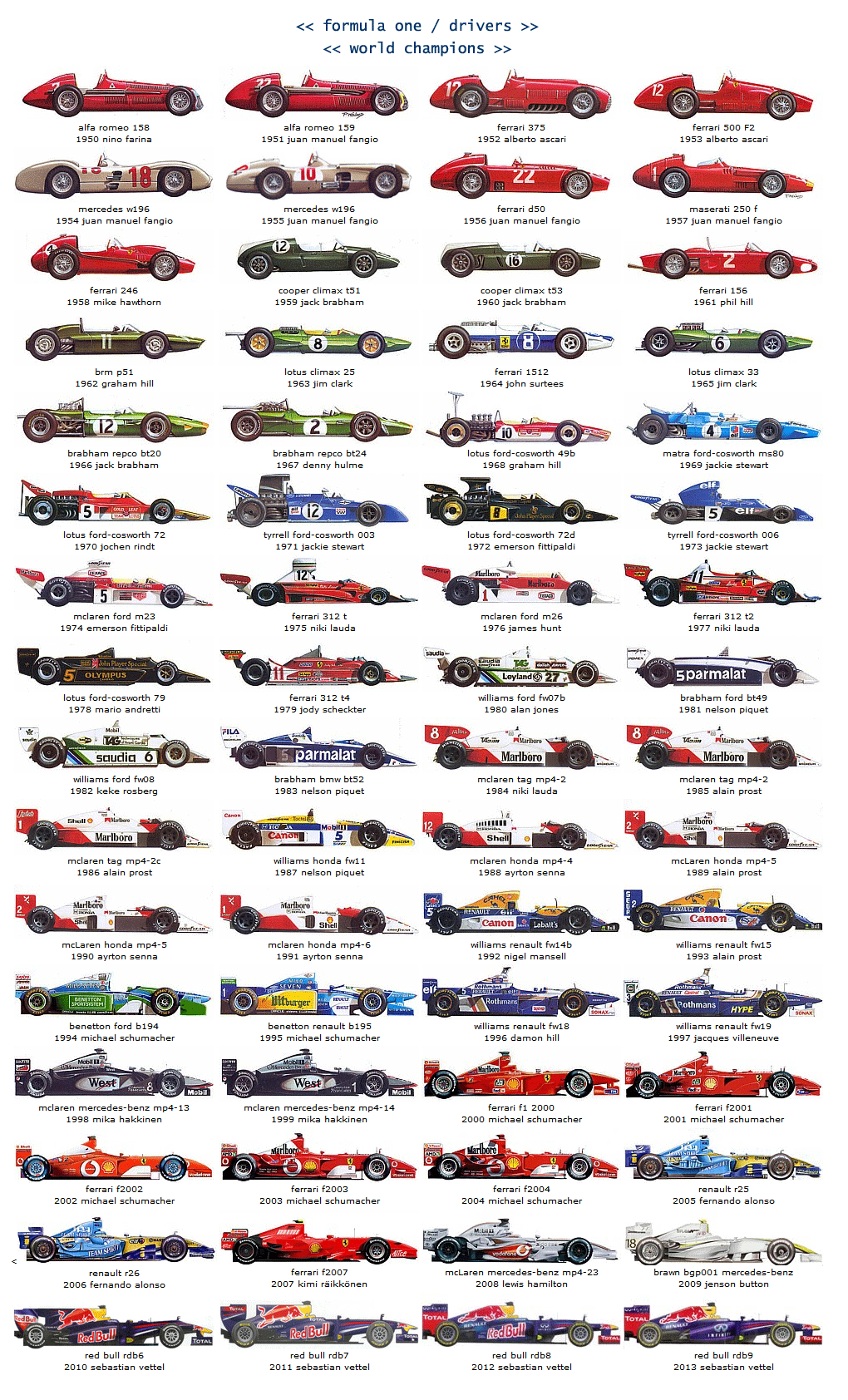
Source: guido / f-1
愛爾蘭F1人偶手辦大師Paul Marshall
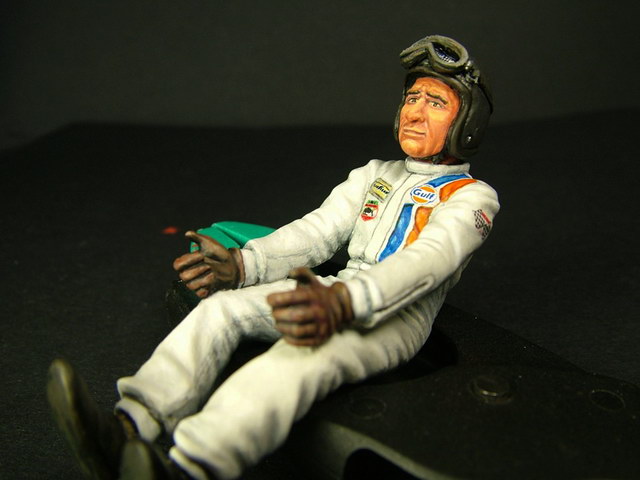
這位來自愛爾蘭Dublin的手辦大師Paul Marshall自幼就對F1產生了濃厚的興趣,所以也啟發了他對製作精緻模型場景和人偶的追求。 在過去的40年裡,他憑著獨特的技術製作出不少令人嘆為觀止的作品。
如果說Scale Figures是一個大規模的俄國人偶製作工廠,那麼Pauls (Mini) Art工作室則是那些追求個人化客戶的不二之選。
另外看到大師也是用西班牙的Vallejo水性油彩來上色的,當然要製作出如此出色的人偶,你一定要有一雙像大師般超穩定的手才行,而這個肯定是天賦的。
關於Steve McQueen的問題
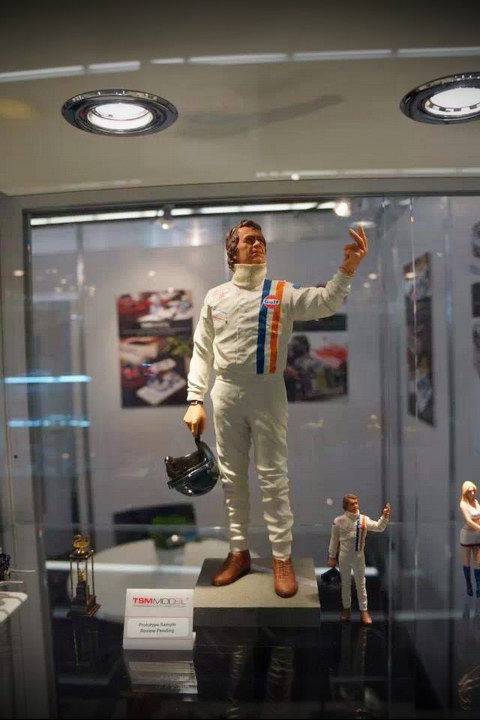
作為一個美國家傳戶曉的人物,Steve McQueen現今的影響力依然不減當年。
很期待TSM今年推出的1比18Steve McQueen人偶,這樣就可以和我那Le Mans電影版的Porsche 917K #20成為一對了。
Q1. Isn’t it a foul language with two fingers up?
Q2. Is the latest Disney car cartoon movie related S. McQueen? As my little nephew always shout “McQueen” “McQueen” with his little toys…so I guess the name must be after American’s well known household name Steve McQueen?
Answer by Will-Laura de Boer-Corsan
Before I talk about the two finger salute, th McQueen your nephew is talking about is lightning McQueen from the movie cartoon called ‘Cars’. I found a Forum answer that makes sense of the two fingered salute. If anyone has a better reponse feel free:
‘The book “A French Kiss with Death” describes the origin of the 2 finger salute.
English longbowmen who fell into the hands of the French, would have their string pulling fingers cut off. This insured that the flower of French knighthood would not suffer again from the same bowman. It goes on to say that before a battle, the English would taunt the French by waving the 2 fingers in the air as a gesture indicating that the fingers remain and the French would move at their peril. Steve McQueen originally wanted to use the American single finger salute, but was offered a more elegant 2 finger version by a British photographer on the set.
Update: Jan 1, 2015
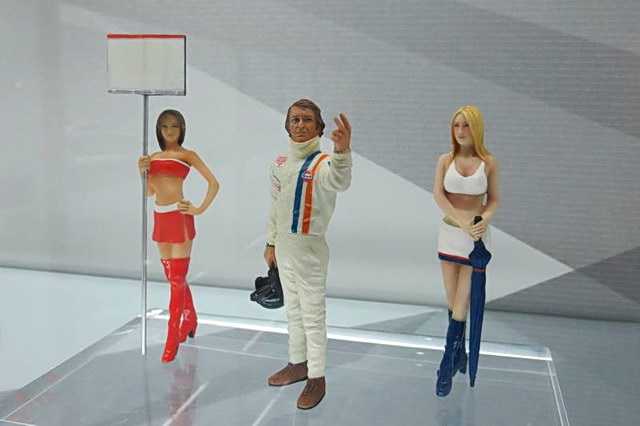
Update: Jan 16, 2016
After almost a year, this figure has been cancelled, what a pity!
” I confirmed this with TSM today. Apparently the Steve McQueen foundation decided not to go ahead with the project. “
Want: 1/18 Alfa Romeo Giulietta 1300 Spider – Red (70157)
If you have this one for sell, please kindly drop me a line with photos and the price you are looking for, thanks!
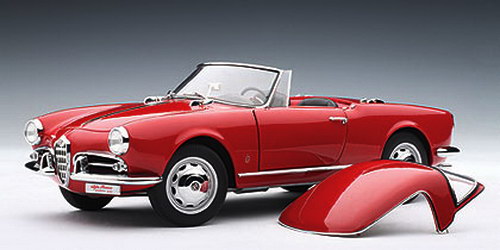
Update: Jan 16, 2015
FOUND and Case Closed!
